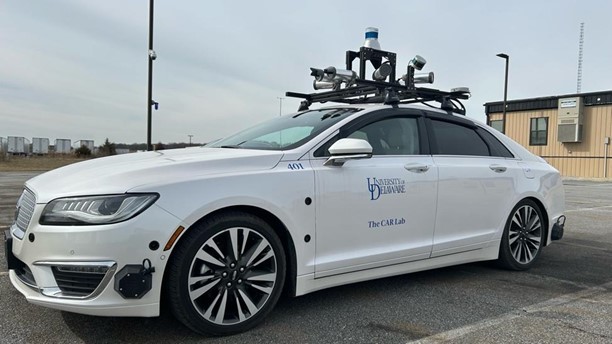Prof. Shi and team are working on understanding the cause of time variations in AV systems and adapting deep neural networks to help analyze and resolve them.
Self-driving cars are the future. More than an important development in the Computer Science and Automotive industries, they are the very image of a future where human innovation and technological advancement work side by side. Of course, to achieve this future, the current systems of these autonomous vehicles (AVs) must first be refined.
Championing such development at the University of Delaware is Weisong Shi, Alumni Distinguished Professor and department chair of Computer and Information Sciences at the University of Delaware. Recently, he was funded by the National Science Foundation Computer Systems Research (NSF CSR) with a three-year, $600,000 grant. This grant supports one core part of the greater development of autonomous vehicle systems which Shi seeks to advance: time variation solutions. Working on this project with Shi as the principal investigator is Shi’s former Ph.D. student Liangkai Liu, and his current Ph.D. student Mingyu Guo. Together this team is at the forefront of autonomous vehicle development.
The central problem to solve with this grant is time variability in AV systems, which stems from the transfer of information. While a program or software might run in five seconds on one computer, it could take much longer when moved to a different device. We might not notice this when it comes to a website loading or a card reader taking longer than usual, but it is an extremely important part of autonomous driving. In these systems, a delay of just milliseconds can be the difference between road safety and a four-car pileup. As such, time variations are a primary focus for Shi, and they play an important part in the whole development of better autonomous driving systems.
In order to develop better and more reliable systems with regard to these time variation issues, Shi and his team are integrating the use of deep neural networks (DNNs). This is a type of multilayered machine learning technology that mimics the neural network of the human brain in order to better adapt to and analyze surroundings. With the refined use of DNNs in this research, autonomous vehicles are prepared to handle a multitude of situations—rain, clouds, terrain changes and more can all be better managed. We as humans can analyze and readjust based on what is immediately before us, and our autonomous cars must be able to do the same before we can use them safely. With the inclusion of DNNs, this possibility becomes a reality, and vehicles can learn to “think” quickly like humans.
The third part of Shi’s research is the determination of exactly what causes time variations. Are they an issue with the system itself? A result of unknown physical factors like the driving environment? Understanding the source of the variations results in predictability, which is key to implementing practical applications of autonomous driving systems. “[In the] real world deployment of autonomous vehicles, they’re fine driving at slow speeds, for example golf courses,” Shi said. “But if you’re driving on the highway and you go 75 miles per hour, then they’re going to have an issue.” To determine the cause of time variations is to bridge the gap between theory and practicality. This is a core part of his research—autonomous vehicles absolutely must be able to function in the unpredictability of real life.
Shi’s work on this project, though, is just one part of a much greater whole. More than the specific study of time variation, he is dealing with autonomous vehicle operating systems as a whole. His Connected and Autonomous Research (CAR) Lab is one of 19 premium members of the open-source Autoware foundation, where they can contribute their software and get feedback from the public, other companies, and academic institutions. “We have been working very closely with the Autoware foundation that makes sure we have the channel to make the real-world impact,” Shi said. This foundation is the facilitator, the connection itself between one team’s research and the greater worldwide communication and collaboration on autonomous driving systems.
The primary location of Shi’s research is in the CAR Lab, hosted on University of Delaware’s Science, Technology and Advanced Research (STAR) campus. His work is physical, tangible and represented in HydraU and HydraD, two real autonomous driving vehicles that function as self-driving research platforms. At the lab, Shi is also working on another project synonymous with this research and grant, coined Delaware Autonomous Vehicle Operating System (DAVOS). “For the future of autonomous vehicles today, [we] don’t really have a very safety-first real-time operating system,” Shi said. “Our goal here is trying to gradually deploy this [research] to be part of the operating system.” DAVOS is, in all respects, a brand-new project. It is a promising one, too, when we think about the context of Shi’s ultimate goals and passion for autonomous driving research as a whole.
This project, specifically focused on addressing time variation solutions in self-driving systems, is one link in an even longer chain of Shi’s research. The development of solutions here is not only necessary for safety, but it is also representative of Shi’s dedication to better autonomous driving operating systems. This is an innovation of incredible significance and recognition, reflective of a better, safer future on the road.

